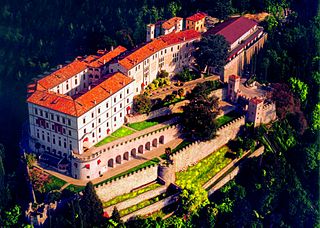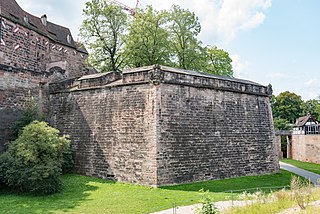
Monreale is a town and comune in the Metropolitan City of Palermo, in Sicily, southern Italy. It is located on the slope of Monte Caputo, overlooking the very fertile valley called "La Conca d'oro", a production area of orange, olive and almond trees, the produce of which is exported in large quantities. The town, which has a population of approximately 39,000, is about 7 kilometres inland (south) of Palermo, the regional capital.

Messina is a harbour city and the capital of the Italian Metropolitan City of Messina. It is the third largest city on the island of Sicily, and the 13th largest city in Italy, with a population of more than 219,000 inhabitants in the city proper and about 650,000 in the Metropolitan City. It is located near the northeast corner of Sicily, at the Strait of Messina and it is an important access terminal to Calabria region, Villa San Giovanni, Reggio Calabria on the mainland. According to Eurostat the FUA of the metropolitan area of Messina has, in 2014, 277,584 inhabitants.

The Forte di Belvedere or Fortezza di Santa Maria in San Giorgio del Belvedere is a fortification in Florence, Italy.

The Strait of Messina Bridge is a planned suspension bridge across the Strait of Messina aimed to connect Sicily with mainland Italy. The bridge would span the cities of Torre Faro in Sicily and Villa San Giovanni in mainland Italy.

The Fort of São João do Arade, sometimes referred to as the Castle of Arade, is a medieval fortification situated in the civil parish of Ferragudo in the Portuguese Algarve municipality of Lagoa.

CastelBrando, former Castrum Costae, is a medieval castle situated on a dolomite limestone rock at an elevation of 370 m (1,210 ft) above sea level, overlooking the villages of Cison di Valmarino and Valmareno, Northern Italy. The name CastelBrando is due to the name Brandolini, the ancient family from Forlì, who were the Lords of the castle.

The walls of Genoa constitute in their whole the several circles of walls that protected and defended the city of Genoa, former capital of the homonymous republic. To this day, large portions of these walls remain, and Genoa has more and longer walls than any other city in Italy.

Mategriffon or Matagrifone or Mathegriffon or Rocca Guelfonia was a medieval castle in Messina, Sicily, located in what is today Viale Principe Umberto. Its strategic position upon a rocky hill close to the historic city centre gave a commanding view of the harbour and Strait of Messina. In the 19th century it was converted into a prison. Prior to its destruction in the 1908 earthquake it comprised a square dungeon with ramparts and reinforced by polygonal towers. Only an octagonal tower remains standing and is incorporated into the 20th century Shrine of Christ the King church, a visible Messina landmark which dominates its skyline.

São Sebastião Museum is a museum, housed in a 16th-century fortress in the city of São Tomé, São Tomé and Príncipe. It lies in the northeastern part of the city centre, at the southeastern end of Ana Chaves Bay. It contains religious art and colonial-era artifacts. The fortress was built in 1566 by the Portuguese in order to protect the port and city of São Tomé against pirate attacks. A lighthouse was established in the fortress in 1866; it was rebuilt in 1928. The fortress was restored at the end of the 1950s.

Antonio Ferramolino was a 16th-century Italian architect and military engineer. He is also known as Sferrandino da Bergamo, and is called Hernan Molin in Spanish sources. He is mostly known for his work in Sicily, but he also designed fortifications in Ragusa and Malta.

Forte Gonzaga, also known as Castel Gonzaga, is a bastioned fort in Messina, Sicily. It was built in the mid-16th century, and it remained in use by the military until 1973. Today, the fort is in good condition.

Forte del Santissimo Salvatore, also known as Castello del Santissimo Salvatore, is a fort in Messina, Sicily. It was built in the mid-16th century, and it is still military property. Some of its walls were demolished after the earthquake of 1908, but the rest of the fort is still intact.

The fortifications of Messina were a series of defensive walls and other fortifications which surrounded the city of Messina, Sicily. The first walls were built during the Middle Ages in around 1200. A system of bastioned fortifications was constructed around the city in the 1530s and 1540s. The fortifications were modified over the years, with the last major addition being the Real Cittadella, which was built in the 1680s. Most of the walls were demolished in the 19th and 20th centuries, but some parts of the walls still survive today.

The Church of the Santissima Annunziata dei Catalani is a church in Messina, Sicily Italy. It is an example of Norman architecture in Sicily.

The Fortaleza de Santo António da Ponta da Mina or Forte de Ponta da Mina is a ruined fort located east of the island capital Santo António in the island of Príncipe in São Tomé and Príncipe. It is located at the headland Ponta da Mina. The fortress consisted of two parts: the Bateria Real and the Bateria do Príncipe.

Forte de Santo Antônio da Barra is a fort located in Salvador, Bahia, Brazil. It was constructed to guard the entrance to the Bay of All Saints, during the time of the Portuguese Empire. The first Portuguese fortification erected in Bahia was likely built in 1501, in the same area now occupied by the Forte de Santo Antônio da Barra. The foundation stone of that first fortification was placed in an area called Ponta do Padrão, now known as the Largo do Farol da Barra, the broad public square in front of the fort. The fort also houses the 22 metres (72 ft)-high Barra Lighthouse and the Nautical Museum of Bahia. The Santo Antônio da Barra Fort is protected as a historic structures by the National Institute of Historic and Artistic Heritage.

Antonio Falzon, also known as Fazuni or by many other variants, was a Maltese architect and military engineer who was a pioneer of Renaissance military architecture in Europe. He is particularly known for his work in Nuremberg, Germany and he is credited with designing some of the earliest bastion fortifications north of the Alps. He is the earliest known notable Maltese architect.

The Fort of Monserrate is a military fortification located in Salvador, Bahia in Brazil. It is also known as the Small Fort of Our Lady of Monserrate. It was known as the Forte de São Felipe from the time of its construction until the 19th century. The Fort of Monserrate was built between the end of the 16th century and early 17th century on the Itapagipe Peninsula. It is "one of the few Brazilian fortifications to retain its original appearance from the late 16th century." The fort is located above the Church and Monastery of Our Lady of Monserrate, one of the oldest church structures in Brazil. The fort was listed as a historic structure by the National Institute of Historic and Artistic Heritage (IPHAN) in 1938.

The Sicilian Renaissance forms part of the wider currents of scholarly and artistic development known as the Italian Renaissance. Spreading from the movement's main centres in Florence, Rome and Naples, when Renaissance Classicism reached Sicily it fused with influences from local late medieval and International Gothic art and Flemish painting to form a distinctive hybrid. The 1460s is usually identified as the start of the development of this distinctive Renaissance on the island, marked by the presence of Antonello da Messina, Francesco Laurana and Domenico Gagini, all three of whom influenced each other, sometimes basing their studios in the same city at the same time.





















